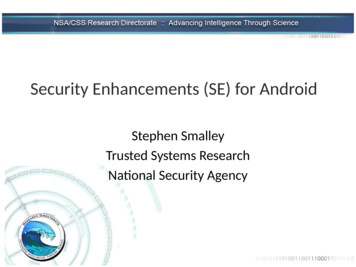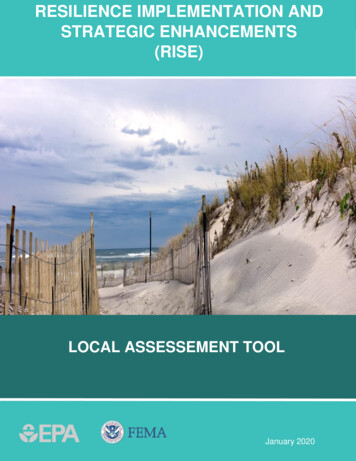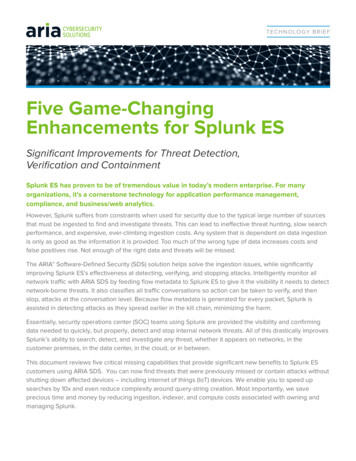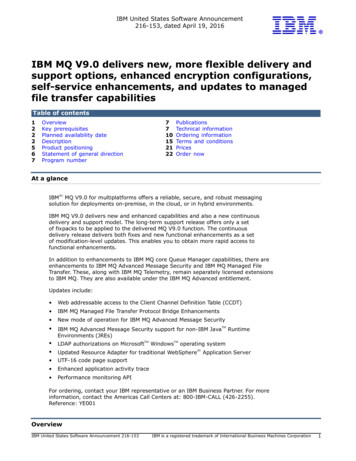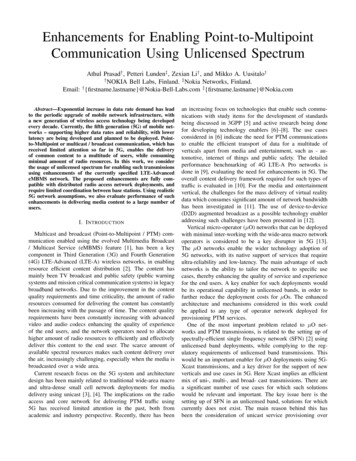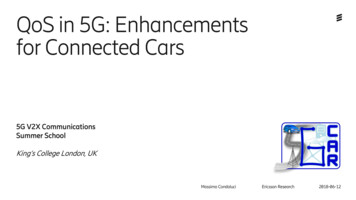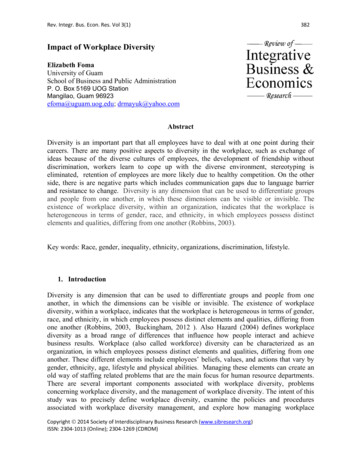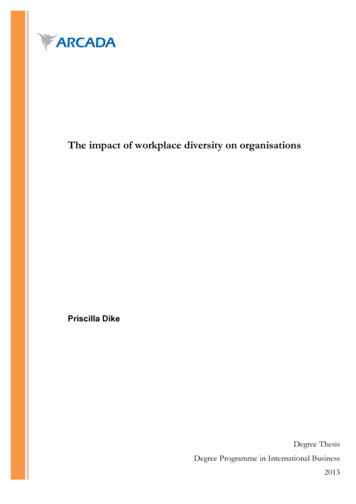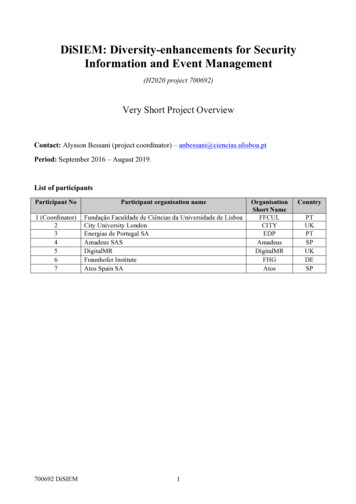
Transcription
DiSIEM: Diversity-enhancements for SecurityInformation and Event Management(H2020 project 700692)Very Short Project OverviewContact: Alysson Bessani (project coordinator) – anbessani@ciencias.ulisboa.ptPeriod: September 2016 – August 2019.List of participantsParticipant NoParticipant organisation name1 (Coordinator)234567Fundação Faculdade de Ciências da Universidade de LisboaCity University LondonEnergias de Portugal SAAmadeus SASDigitalMRFraunhofer InstituteAtos Spain SA700692 DiSIEM1OrganisationShort PTSPUKDESP
Project Key Facts Although a fundamental tool in modern Security Operations Centres, current SIEMs havemany limitations on the methods and means they use to collect events, store data and reportinformation. The cornerstone of the DiSIEM project is the use of scalable information extraction andmachine learning algorithms and tools to extract information from multiple big data sources(sensors in the monitored infrastructures, open-source intelligence, social networks, securitynewsfeeds, advisory organizations, etc.) and feed SIEMs with it for threat prediction andenhanced risk assessment, aided by probabilistic methods and advanced visualisation tools. DiSIEM wants also to equip existing SIEM systems with the capability of evaluating diverseconfigurations of monitoring and protection devices, novel application-based misusedetection and secure cloud-backed long-term archival of selected events. The DiSIEM components can be applied to any existing SIEM that supports customconnectors and provides access to the event store. DiSIEM components can be used either individually or together, broadening the scope inwhich the project results can have impact. DiSIEM components will be validated in production environment for three largeorganisations: an electricity utility company (EDP), a large travel services company(Amadeus) and a SIEM and security provider (Atos). The DiSIEM exploitation business model considers components that will be supported bypartners offering services to SIEM operators (DigitalMR, Atos), internally by partnersoperating large SIEM (Amadeus, EDP) and startup initiatives created primarily from theresearch and development partners (FFCUL, CITY, FHG). The project is organised in 6 technical work packages and 3 additional work packages forethics, dissemination, exploitation and management activities. The project will run for three years, starting in September 2016, with an overall budget ofaround four million euros. The consortium will be assisted and advised by an advisory board including representativesfrom public and private sectors.Current Challenges to Security Management SystemsOrganizations currently monitor and manage the security of their infrastructures by setting up SecurityOperation Centres (SOC) to make security-related decisions (e.g., which system is under attack, what hasbeen compromised, where has an access breach occurred, how many attacks have happened in the last 12hours). A SOC obtains an integrated view of the monitored infrastructure by employing a SecurityInformation and Event Management (SIEM) system. These are complex systems that incorporate thefunctionality to collect logs and events from multiple sources, correlate these events together and thenproduce summarised measurements, data trends and different types of visualisations to help system700692 DiSIEM2
administrators and other security professionals. Due to the nature of the functionality of these systems (thenumber of systems that feed events to them, the different types of events they need to correlate etc.) they arecomplex and costly to deploy and maintain.The SIEM market is a growing one. According to a recent (July 2015) Gartner report (Magic Quadrant forSecurity Information and Event Management), in 2014 the SIEM market grew from 1.5 billion toapproximately 1.69 billion, achieving a growth rate of about 14%. There are many high quality productsfrom large IT vendors. Examples are IBM QRadar,1 HP ArcSight,2 Splunk,3 LogRhythm4 and AlienVaultOSSIM.5 Overall, the Gartner report identified two main drivers for such growth: threat management andcompliance. The spectrum of new attacks (with hundreds of novel kinds of malware each month, includingthe ones related with advanced persistent threats) and the complexity of the IT infrastructures require a wellstructured and integrated monitoring of security events. Additionally, many industries have strictrequirements for compliance,6 especially when it comes to log management, which often mandates the needfor integrated log management functionality, as provided by SIEM systems.Despite their widespread use and the impressive market growth, current SIEMs still have many limitations:1. The threat intelligence capacity of SIEMs is still in its infancy. Consequently, the systems areunable to automatically recognize novel threats that may affect (whole, or parts of) the monitoredinfrastructure, requiring considerable human intervention to adapt and react to changes in the threatlandscape. This happens despite the availability of rich and up-to-date security-related informationsources on the Internet (e.g., social media, blogs, security newsfeeds), which current SIEMs areunable to use.2. Current systems can show any “low-level” data related with the received events, but they havelittle “intelligence” to process this data and extract high-level information. These low-level data(e.g., number of failed logins in a server) are only accessible and meaningful to a limited subgroupof system admins, and are difficult to translate to high-level metrics for senior, C-level managers(such as executives and decision-makers who may need to make decisions on security expenditure,but may not necessarily be well versed in the technical details). This impacts, for instance, thecapacity of SOC coordinators to justify the return on investment in security for an organization.3. Most data visualisation techniques in current SIEMs are rudimentary. Advanced datavisualisation in current SIEMs is still limited. This can seriously impact the ability of the SOCs todeal with incidents as and when they happen, in a timely manner.4. The event correlation capabilities of SIEMs are as good as the quality of the events fed to it.Imprecise events and alarms generated by imperfect monitoring devices will be taken as correct bythe SIEM and the uncertainties associated with these events are never communicated.5. Due to storage and event processing constraints, SIEMs are incapable of retaining the collectedevents for a long duration. This limits their use in conducting forensic investigations in the longrun, for example on advanced persistent threats, or other historical incidents.The Diversity-enhanced SIEM (DiSIEM) project aims to address these limitations by complementingexisting SIEMs with a set of components for accessing diverse data sources, feeding enhanced events to theSIEM and generating enhanced reports and metrics to better support the security operation ance-335282700692 DiSIEM3
DiSIEM ObjectivesThe DiSIEM project aims to address the limitations described above to improve SIEMs already deployed inproduction. Instead of proposing novel architectures for future SIEMs or modifications to existing ones, theproject will address the aforementioned limitations by extending current systems, leveraging their built-incapacity for extension and customisation. The core idea of the project is to enhance existing SIEM systemswith several diversity mechanisms, representing five main advances in the state of the art:1. Integrate diverse OSINT (Open Source Intelligence) data sources available on the web, such asthe NIST’s National Vulnerability Databases, vulnerability and patch databases offered by vendors;threat intelligence data that organisations share with each other (e.g., Internet addresses, URLs andfile reputation databases like SANS ISC, malware domains lists, VirusTotal, ThreatExpert,SpamHaus, OpenBL, EmergingThreats, etc.); security blogs and data streams from social networks(e.g., Twitter, Facebook, LinkedIn), collaborative platforms used in the Dark Web (e.g., Pastebin),search engines and online repositories (e.g., Google Hacking Database, Shodan, RIPE/ARIN,Whois), standards-based Indicators of Compromise or IOC’s (e.g., STIX and OpenIOC), and manyothers. This data needs to be fetched, analysed, normalised and fused to identify relationships, trendsand anomalies and hence help reacting to new vulnerabilities to the new infrastructure or evenpredict possible emerging threats against the infrastructure monitored by the SIEM.2. Develop novel probabilistic security models and risk-based metrics to help security analysts todecide which infrastructure configurations offer better security guarantees and increase the capacityof SOCs to communicate the status of the organisation to C-level managers.3. Design novel visualisation methods to present the diverse live and archival data sets, to bettersupport the decision-making process by enabling the extraction of high-level security insight fromthe data which will be used by the security analysts working with SOCs that operate the SIEM.4. In order to increase the value of the events fed to the system we will integrate diverse, redundantand enhanced monitoring capabilities to the SIEM ecosystem. The idea is to have enhancedsensors and protection tools built using a set of diverse tools. For example, by using three differentintrusion detection systems to monitor the same critical part of the network, we can have a muchhigher confidence on the alarms generated by such systems. Implementing these kinds ofmechanisms requires probabilistic modelling of diversity for security to define which combinationsof tools are more effective and how much improvement can be expected. Likewise, we propose todeploy and integrate novel behavioural anomaly detectors for business-critical applications and thusimprove the SIEM’s visibility into the functional security status of these monitored applications.5. Add support for long term archival of events in public cloud storage services. In order to satisfy thesecurity requirements of such data (which contains a lot of sensitive information), we will store suchevents in diverse cloud providers (e.g., Amazon, Windows Azure, Google), employing techniquessuch as secret sharing and information dispersal.These contributions would be materialized through a set of tools and components, in the form of plugins, thatcan be integrated into existing SIEM systems. For example, redundant diverse analysis and trends obtainedthrough OSINT sources can be fed to the SIEM, while new visualization and analysis tools can be integratedby fetching data from the SIEM event database. The envisioned architecture of a SIEM implementationenhanced with DiSIEM contributions appears in Figure 1.2.Expected ResultsThe main results emanating from this project will be the design and implementation of the severalcomponents illustrated in the red boxes in Figure 1.2:-Techniques and tools for analysing, evaluating and guiding the optimal deployment of diversesecurity mechanisms in the managed infrastructure, including multi-level risk-based metrics(employed in all red boxes in the figure).An OSINT-based security threat predictor (the “OSINT Data Analysis and Fusion” box).A rich set of enhanced interactive visualisations for improving the quality of the decision supportof security analysts operating a SIEM (the “Visualisation and Analysis Tools” box).700692 DiSIEM4
-A framework for deploying diverse and redundant sensors (part of the “Diversity-EnhancedMonitoring” box).A novel application-based anomaly detector for complementing other sensors and detect fraud inapplication servers (“Diversity-Enhanced Monitoring” box).Components that allow for long-term event archival in diverse clouds (the “Cloud-of-clouds EventArchival” box).By choosing the extension approach instead of developing a new SIEM (or expecting vendors to change theirsystems to accommodate our enhancements), we expect to foster innovation much faster, and maximize theimpact and business potential of the project results.Figure 1.2: DiSIEM architecture around an existing SIEM (red boxes represent our key contributions).700692 DiSIEM5
700692 DiSIEM 2 Project Key Facts Although a fundamental tool in modern Security Operations Centres, current SIEMs have many limitations on the methods and means they use to collect events, store data and report information. The cornerstone of the DiSIEM project is the use of scalable information extraction and machine learning algorithms an

